| |
Reyataz/r vs Kaletra Study 045 96 Wks Experienced Patients
|
| |
| |
"96-week comparison of once-daily atazanavir/ritonavir and twice-daily lopinavir/ritonavir in patients with multiple virologic failures"
AIDS: Volume 20(5) 21 March 2006 p 711-718
Johnson, Margareta; Grinsztejn, Beatrizb; Rodriguez, Claudiac; Coco, Jeffreyd; DeJesus, Edwine; Lazzarin, Adrianof; Lichtenstein, Kennethg; Wirtz, Victoriah; Rightmire, Annah; Odeshoo, Lindah; McLaren, Colinh
From the aRoyal Free Hospital, London, UK
bInstituto de Pesquisa Clinica Evandro Chagas-Fiocruz, Rio de Janeiro, Brazil
cHospital Argerich, Buenos Aires, Argentina
dPendleton Memorial Methodist Hospital, New Orleans, Louisiana
eIDC Research Initiative, Altamonte Springs, Florida, USA
fS. Raffaele Hospital, Milan, Italy
gUniversity of Colorado Health Sciences, Denver, Colorado, USA
hBristol-Myers Squibb Pharmaceutical Research Institute, Wallingford, Connecticut, USA.
Abstract
Background: In BMS Study 045, once-daily (QD) atazanavir/ritonavir (ATV/RTV) demonstrated comparable efficacy and safety to twice-daily (BID) lopinavir/ritonavir (LPV/RTV) over 48 weeks in treatment-experienced patients. Results of extended follow-up to 96 weeks are presented.
Methods: BMS Study 045 was an open-label, randomized, multi-national trial of HIV-infected patients with virologic failure on two or more prior HAART regimens designed to evaluate the efficacy and safety of ATV/RTV (300/100 mg) QD and LPV/RTV (400/100 mg) BID, each with tenofovir (300 mg) QD and one nucleoside reverse transcriptase inhibitor. The primary efficacy measure was the time-averaged difference (TAD) in reduction in HIV RNA from baseline. Secondary objectives included evaluation of safety and plasma lipid levels through week 96.
Results:
Over 96 weeks, the ATV/RTV regimen demonstrated similar virologic efficacy to the LPV/RTV regimen. Mean reductions from baseline in HIV RNA were -2.29 and -2.08 log10 copies/ml, respectively [TAD (97.5% confidence interval): 0.14 log10 copies/ml (-0.13, 0.41)].
The LPV/RTV regimen resulted in significant increases in total cholesterol (+9%) and fasting triglycerides (+30%) in comparison with the ATV/RTV regimen, which demonstrated decreases in these parameters [-7 and -2%, respectively, (P < 0.0001)].
Grade 2-4 diarrhoea occurred less frequently in ATV/RTV patients (3%) in comparison with LPV/RTV patients (13%) (P < 0.01).
Grade 3-4 elevations in bilirubin were more common in ATV/RTV patients (53%) than LPV/RTV patients (< 1%) (P < 0.0001), with no resulting discontinuations.
Conclusions: Regimens containing once-daily ATV/RTV demonstrated comparable efficacy and safety, with significant reductions in total cholesterol and fasting triglycerides and improved gastrointestinal-tolerability in comparison with twice-daily regimens containing LPV/RTV over 96 weeks in treatment-experienced patients.
Introduction
Durable therapeutic options for antiretroviral treatment-experienced patients are limited. As patients transition to later antiretroviral regimens, increased failure rates become more prevalent [1-4]. As a further confounding factor, a complication of protease inhibitor (PI)-based regimens is the usual association with metabolic abnormalities such as dyslipidemia, lipodystrophy and insulin resistance [5-7], which may lead to increased long-term cardiovascular risk factors in HIV-infected patients [8-12].
A 48-week analysis of BMS Study 045 in treatment-experienced patients who had failed multiple HAART regimens demonstrated that atazanavir (ATV) with ritonavir (RTV) had comparable virological efficacy to lopinavir (LPV)/RTV, each administered with one nucleoside reverse transcriptase inhibitor (NRTI) and tenofovir (TDF). In this study, ATV/RTV therapy was associated with less of the deleterious lipid effects and gastrointestinal tolerability issues often associated with PI therapy than LPV/RTV [13], confirming previous findings of ATV from earlier clinical trials [14,15]. This study was amended prior to the week 48 analysis in order to evaluate the long-term efficacy and safety of ATV/RTV versus LPV/RTV and the findings of the 96-week data are presented in this report.
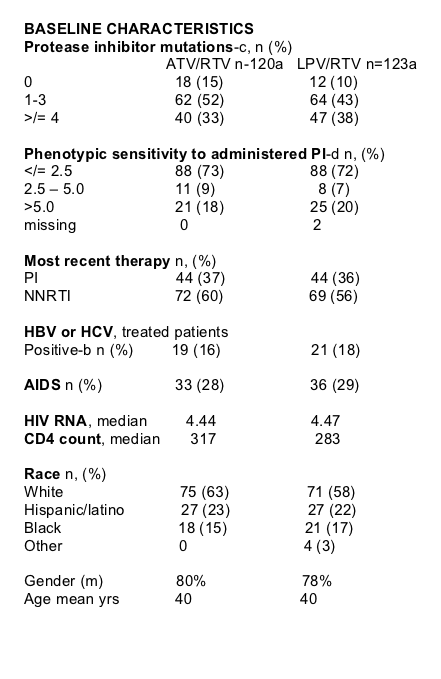
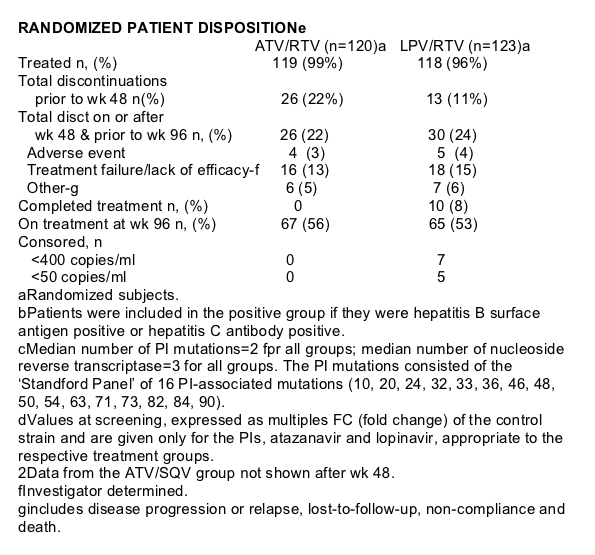
aRandomized subjects.
bPatients were included in the positive group if they were hepatitis B surface antigen positive or hepatitis C antibody positive.
cMedian number of PI mutations=2 fpr all groups; median number of nucleoside reverse transcriptase=3 for all groups. The PI mutations consisted of the 'Standford Panel' of 16 PI-associated mutations (10, 20, 24, 32, 33, 36, 46, 48, 50, 54, 63, 71, 73, 82, 84, 90).
dValues at screening, expressed as multiples FC (fold change) of the control strain and are given only for the PIs, atazanavir and lopinavir, appropriate to the respective treatment groups.
2Data from the ATV/SQV group not shown after wk 48.
fInvestigator determined.
gincludes disease progression or relapse, lost-to-follow-up, non-compliance and death.

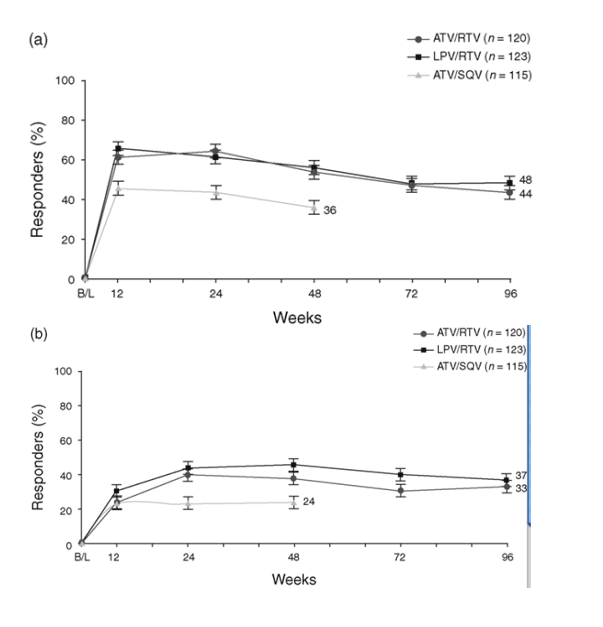
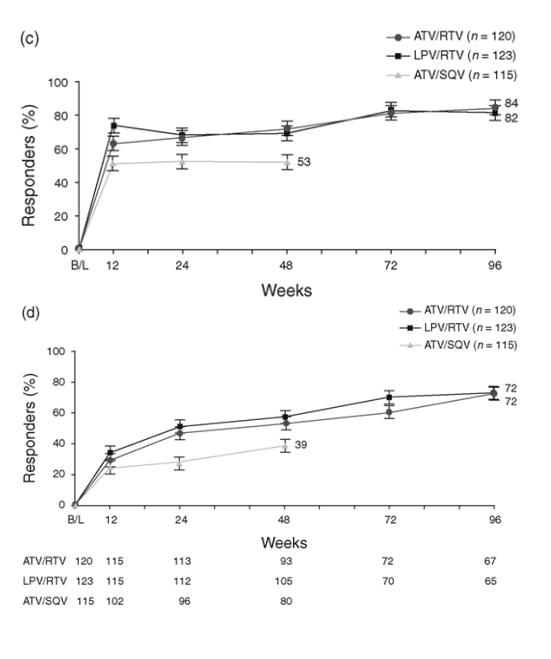
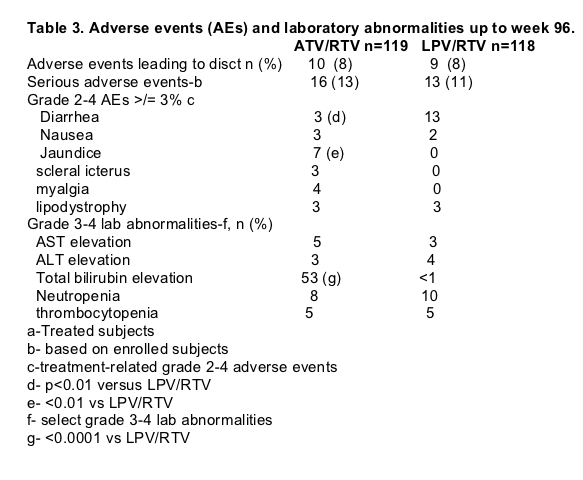
Patient population and study design
The methodology for this study, including assessment and monitoring criteria, has been previously reported [13]. Subjects who had previously failed two or more prior HAART regimens [(that cumulatively included one or more NRTI, non-nucleoside reverse transcriptase inhibitor (NNRTI) and PI)] were randomized in equal numbers to unblinded oral therapy with one of three antiretroviral regimens: (1) ATV 300 mg plus RTV 100 mg once daily (QD), (2) ATV 400 mg plus saquinavir (SQV) 1200 mg QD, or (3) LPV/RTV 400/100 mg twice daily (BID). Patients in each group also received TDF 300 mg QD plus one NRTI: didanosine (ddI) 400 mg QD (reduced total doses of 200 or 250 mg QD, depending on body weight, were recommended after the start of the trial due to the identification of a pharmacokinetic interaction between ddI and TDF that increased ddI concentrations [16]), stavudine 40 mg BID, lamivudine 150 mg BID, zidovudine 300 mg BID, or abacavir 300 mg BID. The NRTI component was chosen by the investigators on the basis of phenotypic sensitivity analyses performed at screening. If this information was not available, the patient was assigned to an NRTI to which he or she was naive. An interim analysis conducted at week 24 indicated that the efficacy of the ATV/SQV arm was inferior to LPV/RTV and an amendment gave patients the option of changing therapy. As a result, efficacy or safety results for the ATV/SQV arm are not presented beyond week 48. Prior to the week 48 analysis, the study was amended to extend the ATV/RTV and LPV/RTV treatment arms through at least 96 weeks.
Primary and secondary analyses
The primary efficacy endpoint analysis compared the magnitude and durability of the reduction in plasma HIV RNA from baseline, based on the time-averaged difference (TAD) through week 96, between ATV/RTV and LPV/RTV. Secondary efficacy assessments included the proportion of patients with plasma HIV RNA < 400 and < 50 copies/ml and the change from baseline in CD4 cell count through week 96. Safety assessments included general safety and tolerability as well as the magnitude of changes in total cholesterol (TC), high-density lipoprotein cholesterol (HDL-C), fasting low-density lipoprotein cholesterol (LDL-C) and fasting triglycerides (TG). Usage of lipid-lowering therapy and anti-diarrheal agents was also evaluated. Post-hoc analyses were performed to evaluate virological response by NRTI backbone and by number of PI mutations at baseline, using the 'Stanford Panel'.
Statistical analyses
The study was designed with 99% power to demonstrate that the magnitude and durability of the reduction in log10 plasma HIV RNA from baseline in terms of the TAD were similar for each ATV regimen compared to LPV/RTV. Regimens were determined to be similar (non-inferior) in the primary efficacy analysis if the upper 97.5% confidence interval (CI) limit for the TAD (ATV - LPV/RTV) was < 0.5 log10 copies/ml.
The percentages of patients with HIV RNA levels < 400 copies/ml and < 50 copies/ml were assessed as secondary efficacy outcome measures using both intent-to-treat (ITT) and as-treated (AT) analyses. The protocol-defined ITT analyses considered non-completers as treatment failures (NC = F) and included all randomized patients in the denominator. Following the amendment to extend the study to 96 weeks, 10 patients (8%) in the LPV/RTV arm completed their 48-week commitment and elected not to continue through to 96 weeks. Therefore, an additional ITT analysis was conducted which censored patients randomized to LPV/RTV from the numerator and denominator whose HIV RNA measurements were below the level of quantification and discontinued study treatment citing the reason 'completed treatment'.
Two ITT analyses, using the time to loss of virologic response (TLOVR) and treatment response without prior failure (TRWPF) definitions of response, were conducted on both the censored and the uncensored data. TLOVR used a response definition of a minimum of two sequential HIV RNA measurements < LOQ (limit of quantification) maintained through week 96 without an intervening confirmed virologic rebound or treatment discontinuation. In addition to rebound and discontinuation, the TRWPF analysis counted patients with new-onset AIDS-defining events as failures. Patients who remained on study at week 96 were included in the AT analyses with response based only on the week 96 HIV RNA measurement being < 400 copies/ml (or < 50 copies/ml), or both the previous and subsequent measurements being < 400 copies/ml (or < 50 copies/ml) if the week 96 measurement was missing.
Assessment of safety endpoints included all treated patients. Serious adverse events (SAEs) and deaths were included without regard to treatment status at the time of onset for enrolled patients. Mean percent changes from baseline for lipid parameters were analyzed, excluding values obtained after the start of lipid-lowering therapy. To evaluate the difference between the two arms, last observation carried forward methodology was utilized for values prior to treatment discontinuation or initiation of lipid-reducing agents.
RESULTS
A total of 571 patients were screened for enrollment; 358 patients were randomized between November 2001 and August 2002, and 347 (97%) were treated. Table 1 provides disposition information for the ATV/RTV and LPV/RTV treatment arms; disposition information for the ATV/SQV arm is not included as results of this arm are not presented beyond week 48. Baseline characteristics were comparable across treatment arms (Table 1). The mean time on study therapy was 76 weeks for the ATV/RTV and LPV/RTV treatment arms. Overall, discontinuations of on-treatment study therapy during the period from week 48 to week 96 were comparable for both treatment arms.
Efficacy
The mean reductions from baseline HIV RNA at 96 weeks were -2.29 log10 copies/ml for the ATV/RTV arm and -2.08 log10 copies/ml for the LPV/RTV arm (Fig. 1). Similarity (non-inferiority) of antiviral efficacy of ATV/RTV and LPV/RTV regimens was demonstrated for the primary efficacy endpoint through week 96. The overall estimate for ATV/RTV - LPV/RTV TAD (97.5% CI) was 0.14 log10 copies/ml (-0.13, 0.41).
All secondary ITT analyses (TLOVR and TRWPF, NC = F and censored) and the AT analyses of the proportion of patients with HIV RNA levels < 400 copies/ml and < 50 copies/ml supported the conclusion of comparable efficacy between ATV/RTV and LPV/RTV demonstrated in the primary endpoint (Table 2, Fig. 2).
A post-hoc analysis was conducted to determine the influence of PI mutations at baseline on virologic response. The magnitude of response to both the ATV/RTV and the LPV/RTV regimens was inversely related to the number of baseline PI mutations. The decline in HIV RNA from baseline through week 96 was similar in subjects treated with ATV/RTV in comparison with those treated with LPV/RTV having less than four PI mutations, -2.47 and -2.21 log10 copies/ml, respectively [ATV/RTV - LPV/RTV TAD (CI): 0.04 (-0.23, 0.31)]. The response in patients with four or more PI mutations treated with ATV/RTV compared to those treated with LPV/RTV was -1.71 and -1.81 log10 copies/ml, respectively, [ATV/RTV - LPV/RTV TAD (CI): 0.44 (0.06, 0.83)]. The ITT analyses of virologic response for less than four and four or more PI mutations are shown in Table 2.
As noted previously, the dose of ddI was adjusted due to the identification of a drug-drug interaction between ddI and TDF [16,17]. To assess the impact of dose reduction of ddI with TDF on study efficacy, a post-hoc analysis was performed. Fifty-one percent of patients received ddI as part of their regimen (ATV/RTV, 58%, LPV/RTV, 47%). Virologic efficacy was comparable in patients who did and did not receive ddI. At week 96, the declines from baseline in HIV RNA for patients in the ATV/RTV and LPV/RTV arms who received ddI were -2.38 and -2.00 log10 copies/ml in comparison with -2.15 and -2.17 log10 copies/ml for patients who did not receive ddI.
At week 96, median increases in CD4 cell count for patients treated with ATV/RTV and LPV/RTV were 160 and 142 cells/ml, respectively.
Adverse events and laboratory abnormalities
Treatment-related, grade 2-4 clinical adverse events ≥ 3% and select grade 3-4 laboratory abnormalities are summarized in Table 3. Adverse events leading to discontinuation of treatment in the second year of study therapy occurred with an incidence consistent with the first year of the study (ATV/RTV 3%, LPV/RTV, 4%). Over the complete course of the study, SAEs were experienced by 16 (13%) ATV/RTV patients and 13 (11%) LPV/RTV patients. The types and patterns of individual SAEs on each regimen were consistent with the underlying disease status of the subjects and the known side-effect profiles of the study drugs and do not suggest any new drug-related toxicities. Three deaths were reported: one in the ATV/SQV group and two in the LPV/RTV group; none were considered by the investigator to be related to study medication.
Treatment-related, grade 2-4 gastrointestinal disorders occurred more often in LPV/RTV patients than in ATV/RTV patients (19 versus 9%, P < 0.05). Grade 2-4 diarrhoea occurred more frequently in LPV/RTV patients than in ATV/RTV patients (13 versus 3%, P < 0.01) with a greater number of new-onset events in the first compared to the second year of LPV/RTV (13 and two subjects, respectively). This higher rate of diarrhoea in LPV/RTV patients was associated with greater use of antidiarrhoeal agents (25%) versus ATV/RTV patients (6%) (P < 0.0001). Treatment-related, grade 2-4 jaundice and scleral icterus occurred only in the ATV/RTV arm (eight and four subjects, respectively), with most cases (seven and four, respectively) in the first year.
New-onset grade 3-4 elevations of bilirubin levels in the second year were noted only in five subjects receiving ATV/RTV, in contrast to 24 cases in the first year; no discontinuations resulted. Grade 3-4 elevations in bilirubin were not associated with increases in hepatic transaminase levels, which were infrequent across all study regimens. Adverse renal events were infrequent and occurred in five subjects, who were all treated with LPV/RTV in combination with TDF and ddI. The majority occurred after 1 year of dosing (range 26 to 856 days). Discontinuation of therapy occurred in three subjects (one renal insufficiency in the context of an amitriptyline overdose, one renal tubular acidosis, one Fanconi syndrome). Two subjects reported a single episode of a grade 3 elevation in creatinine levels which in one case was associated with an SAE of renal insufficiency. No novel adverse events were observed in analyses of new-onset adverse events after week 48 for either regimen.
Lipids
Lipid profiles improved on the ATV/RTV regimen but not in patients treated with LPV/RTV. The greatest changes in lipid parameters were observed by week 12 and were maintained through 96 weeks in both treatment arms. In the ATV/RTV and LPV/RTV treatment groups, respectively, median TC levels were 182 and 178 mg/dl at baseline, 166 and 188 mg/dl at week 48 and 177 and 187 mg/dl at week 96; median HDL-C levels were 38 and 37 mg/dl at baseline, 37 and 40 mg/dl at week 48 and 41 and 42 mg/dl at week 96; median fasting LDL-C levels were 100 and 103 mg/dl at baseline, 93 and 99 mg/dl at week 48, and 94 and 93 mg/dl at week 96; and median fasting TG levels were 164 and 163 mg/dl at baseline, 138 and 179 mg/dl at week 48 and 124 and 203 mg/dl at week 96.
Over the course of the study, lipid-lowering therapy was used by 9% of ATV/RTV patients versus 20% of LPV/RTV patients (P < 0.05) compared with 6 and 5%, respectively, at baseline. Changes from baseline to week 96 (excluding lipid measurements from subjects who initiated lipid-lowering therapy) for TC, HDL-C, LDL-C and TG for patients treated with ATV/RTV were -7, -5, -11 and -2%, respectively. The respective values for LPV/RTV (P value versus ATV/RTV) were +9% (P < 0.0001), +7% (NS), +1% (NS) and +30% (P < 0.0001). Changes from baseline in lipid parameters at week 96 were consistent with those observed in the week 48 analysis [13].
DISCUSSION
In the primary efficacy analysis of TAD in change from baseline in HIV RNA level through week 96, similar antiviral efficacy between ATV/RTV and LPV/RTV was demonstrated. Although this study lacked statistical power for the secondary comparison of the proportions below the HIV RNA lower limit of detection, all ITT analyses and the AT analysis consistently supported the primary efficacy measure through the second year. As the majority of patients were on an NNRTI regimen immediately prior to study entry, the impact of PI mutations on baseline genotyping and phenotyping may have been underestimated at screening, thereby affecting the post-hoc analysis of antiviral efficacy stratified by baseline PI mutations. This analysis demonstrated a more favourable response in patients with less than four mutations than those with four or more mutations. Interpretation of the data of patients with four or more PI mutations at baseline is limited due to the small number of subjects in this group. However, it appears that the number of baseline primary PI mutations may affect the virologic response to both ATV/RTV and LPV/RTV.
In a previous study in treatment-experienced patients and in separate pharmacokinetic analyses, a bidirectional drug-drug interaction was observed between ATV and TDF. ATV concentrations were decreased 25-28% when ATV was administered with RTV (300/100 mg) and TDF in HIV patients and 11-14% in healthy volunteers [18,19]. Despite such interactions, the ATV/RTV regimen examined in this study demonstrated comparable efficacy to LPV/RTV in PI-experienced patients.
Along with the demonstration of sustained, comparable efficacy, several positive results were observed in the ATV/RTV regimen studied in this trial. No novel, unexpected adverse events occurred with the ATV/RTV regimen during the second year of treatment. Of note, the incidence of new-onset bilirubin events declined in year two, and no discontinuations were observed due to jaundice or scleral icterus throughout study conduct. ATV/RTV continued to demonstrate a favourable gastrointesinal profile, especially with respect to the incidence of moderate to severe diarrhoea, which occurred significantly less frequently compared with LPV/RTV.
Another positive result observed in the ATV/RTV regimen was the improvement in the lipid profile for those subjects randomized to ATV/RTV. Despite the presence of RTV, which has been previously associated with adverse increases in lipid levels [20-22], treatment with ATV/RTV resulted in significantly lower TC and TG levels when compared with LPV/RTV. Improvements in lipid parameters in the ATV/RTV arm were observed by week 12 and were maintained throughout the study.
As a result of the lower incidence of diarrhoea and favourable lipid parameters among patients receiving ATV/RTV, significantly less use of either antidiarrhoeal or lipid-lowering agents was observed. In treatment-experienced patients receiving multiple medications, this reduction in concomitant therapy may minimize the potential for drug interactions while improving tolerability and convenience of dosing.
In summary, this trial demonstrated that, in this treatment-experienced population, ATV/RTV QD in combination with TDF and one NRTI exhibited comparable, durable efficacy to LPV/RTV BID and was not associated with any unexpected or late-emerging adverse events. The findings of this 96-week analysis suggest that the long-term use of ATV/RTV may decrease pill burden, improve tolerability and provide sustained virologic suppression for antiretroviral-experienced patients with HIV infection.
|
|
| |
| |
|
|
|